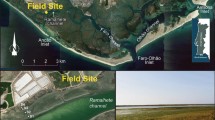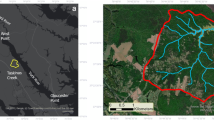Abstract
The movement of organic carbon was assessed by statistical and simulation modeling analyses in two marsh types in New Jersey;each marsh contained three water-drainage systems in which three tidal cycles were sampled in May and June 1973. Hourly water samples were obtained and filtered through a gelman Type A glass filter for separation into dissolved (DOC) and particulate (POC) organic carbon components of the total organic carbon (TOC). Simulation data showed that individual creeks and marshes functioned differently on the sampled tidal cycles in regard to net movement of water and organic carbon components. Organic carbon components exhibited similar tidal variations, with significantly lower concentrations at flood slack than at ebb slack. Mid-ebb concentrations were significantly higher than mid-flood concentrations for TOC and POC. Individual marshes showed significantly different concentrations in the latter segments of the tidal cycle for TOC's and POC's. Results indicate that individual creeks, marshes and tidal cycles are not representative of the total movement of organic carbon in estuaries.
Similar content being viewed by others
Literature Cited
Boon, J.D.: Tidal discharge asymmetry in a salt marsh drainage system. Limnol. Oceanogr. 20, 71–80 (1975)
Darnell, R.M.: The organic detritus problem. In: Estuaries, pp 374–375. Ed. by G. Lauff. Washington, D.C.: American Association for the Advancement of Science 1967. (Publs Am. Ass. Advmt Sci. No. 83)
DeWitt, P. and F.C. Daiber: The hydrography of the Broadkill River Estuary, Delaware. Chesapeake Sci. 14, 28–40 (1973)
Erkenbrecher, C.W. and L.H. Stevenson: The influence of tidal flux on microbial biomass in salt marsh creeks. Limnol. Oceanogr. 20, 618–625 (1975)
Ferrigno, F. and D.M. Jobbins: A summary of nine years of applied mosquito-wildlife research on Cumberland County, N.J. salt marshes. Proc. New Jers. Mosq. Exterm. Ass. 53, 97–113 (1968)
Gardner, L.R.: Runoff from an intertidal marsh during tidal exposure—recession curves and chemical characteristics. Limnol. Oceanogr. 20, 81–89 (1975)
Heald, E.J.: The production of organic detritus in a south Florida estuary. Tech. Bull. Sea Grant Progm. Univ. Miami 6, 1–110 (1971)
Hood, D.W. (Ed.): Symposium on organic matter in natural waters. Occ. Publs Inst. mar. Sci. Univ. Alaska Coll. 1, 1–625 (1970)
Nixon, S.W. and C.A. Oviatt: Analysis of local variation in the standing crop of Spartina alterniflora. Botanica mar. 16, 103–109 (1973)
Odum, E.P.: Halophytes, energetics and ecosystems. In: Ecology of halophytes, pp 599–602. Ed. by R.J. Reimold and W.H. Queen. New York: Academic Press 1974
— and A.A. de la Cruz: Particulate organic detritus in a Georgia salt marsh-estuarine ecosystem. In: Estuaries, pp 383–388. Ed. by G. Lauff. Washington, D.C.: American Association for the Advancement of Science 1967. (Publs Am. Ass. Advmt Sci. No. 83)
Odum, W.E., J.C. Zieman and E.J. Heald: The importance of vascular plant detritus to estuaries. In: Proceedings of the Coastal Marsh and Estuary Management Symposium, pp 91–114. Ed. by R.H. Chabreck. Baton Rouge, Louisiana, USA: Louisiana State University, Division of Continuing Education 1973
Parker, P.L. and J.A. Calder: Stable carbon isotope ratio variations in biological systems. Occ. Publs Inst. mar. Sci. Univ. Alaska Coll. 1, 107–127 (1970)
Phleger, C.F.: Effect of salinity on the growth of a salt marsh grass. Ecology 52, 908–911 (1971)
Schultz, D.M. and J.G. Quinn: Fatty acid composition of organic detritus from Spartina alterniflora. Estuar. cstl mar. Sci. 1, 177–190 (1973)
Sharp, J.H.: Size classes of organic carbon in sea water. Limnol. Oceanogr. 18, 441–447 (1973)
Steever, E.Z.: Tidal salt marsh production studies in Connecticut. Bull. ecol. Soc. Am. 54, (Abstract) (1972)
Teal, J.M.: Energy flow in the salt marsh ecosystem of Georgia. Ecology, 43, 614–624 (1962)
Valiela, I. and J.M. Teal: Nutrient limitation in salt marsh vegetation. In: Ecology of halophytes, pp 547–563. Ed. by R.J. Reimold and W.H. Queen, New York: Academic Press 1974
Williams, R.B. and M.B. Murdock: Compartmental analysis of the production of Juncus roemerianus in a North Carolina salt marsh. Chesapeake Sci. 13, 69–79 (1972)
Zar, J.H.: Biostatistical analysis, 620 pp. Englewood Cliffs, New Jersey: Prentice-Hall, Inc. 1974
Author information
Authors and Affiliations
Additional information
Communicated by M.R. Tripp, Newark
Paper of the Journal Series, New Jersey Agricultural Experiment Station, Cook College, rutgers—The state University of New Jersey, New Brunswick, New Jersey 08903, USA.
Rights and permissions
About this article
Cite this article
Shisler, J.K., Jobbins, D.M. Tidal variations in the movement of organic carbon in New Jersey salt marshes. Marine Biology 40, 127–134 (1977). https://doi.org/10.1007/BF00396258
Accepted:
Issue Date:
DOI: https://doi.org/10.1007/BF00396258




